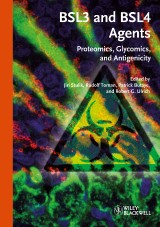Details

BSL3 and BSL4 Agents
Proteomics, Glycomics and Antigenicity1. Aufl.
|
111,99 € |
|
| Verlag: | Wiley-Blackwell |
| Format: | |
| Veröffentl.: | 04.10.2011 |
| ISBN/EAN: | 9783527638215 |
| Sprache: | englisch |
| Anzahl Seiten: | 256 |
DRM-geschütztes eBook, Sie benötigen z.B. Adobe Digital Editions und eine Adobe ID zum Lesen.
Beschreibungen
Unique coverage of proteomic and glycomic approaches to better distinguish highly dangerous pathogens, as well as using these to explore novel treatment and prevention options. <br> The editors and authors are either part of a specialized European network initiated to develop fast and reliable detection and therapy options, or are associated with the core military research complex of the United States.<br> With its description of the methods, their advantages and limitations, as well as the principle outcomes, this is a must-have resource for all professionals dealing with BSL3 and/or BSL 4 agents.<br>
Preface<br> Introduction: Application of proteomic technologies for the analysis of microbial infections<br> (Jiri Stulik and Patrick Butaye)<br> <br> BASIC PROTEOMIC METHODS<br> Separation of proteins and peptides<br> (Ludovit Skultety)<br> Basic mass spectrometric approaches<br> (Lenka Hernychova and Martin Hubalek)<br> Quantitative mass spectrometric approaches<br> (Juraj Lenco and Vojtech Tambor)<br> BN-PAGE of microbial protein complexes<br> (Jiri Dresler and Jana Klimentova)<br> Analysis of Francisella tularensis glycoproteins<br> (Lenka Hernychova and Lucie Balonova)<br> <br> IDENTIFICATION OF PROTEINS AS WELL AS GLYCANS FROM MICROORGANISMS AS CANDIDATE MOLECULES FOR USE IN DETECTION/DIAGNOSIS, THERAPY AND PROPHYLAXIS<br> Comparative proteome analysis of strains with differential virulence<br> (Martin Hubalek and Ivona Pavkova)<br> Analysis of Francisella tularensis acetonitrile extracts<br> (Lenka Hernychova, Martin Hubalek and J. Udrzalova)<br> Analysis of culture filtrate proteins of Francisella tularensis<br> (Klara Konecna and Lenka Hernychova)<br> Lipopolysaccharides of Coxiella burnetii: Chemical composition and structure, and their role in diagnosis of Q Fever<br> (Rudolf Toman and Pavol Vadovic)<br> Mimivirus possess anonymous and unique gene products<br> endowed for antigenic properties<br> (Patricia Renesto and Didier Raoult)<br> Detection of differentially modified pathogen proteins by Western Blot after<br> 2-D gel electrophoresis and identification by MALDI-TOF/TOF<br> (Fred Fack, Julia Kessler, Patrick Pirrotte, Jacques Kremer, Dominique Revets, Wim Ammerlaan and Claude P. Muller)<br> Composition and structure of lipids A of the intracellular bacteria Piscirickettsia salmonis and Coxiella burnetii<br> (Pavol Vadovic, Robert Ihnatko and Rudolf Toman)<br> Proteins of Coxiella burnetii and analysis of their function<br> (Robert Ihnatko, Pavol Vadovic and Rudolf Toman)<br> Subtype and toxin variant identification of Botulinum neurotoxin Type A using proteomics techniques<br> (Suzanne R. Kalb, Jakub Baudys, Theresa J. Smith, James L. Pirkle and John R. Barr)<br> Protein microarrays for antigen discovery<br> (Mohan Natesan, Sarah Keasey and Robert G. Ulrich)<br> MALDI-TOF mass spectrometry for rapid identification of highly pathogenic microorganisms<br> (Peter Lasch and Dieter Naumann)<br> <br> ANALYSIS OF HOST PATHOGEN INTERACTIONS<br> Quantitative proteomic profiling of host - pathogen interactions: The interaction of Francisella tularensis LVS with macrophages using J774.2 cell line<br> (Anetta Hartlova, Marek Link, Juraj Lenco and Jiri Stulik)<br> Proteome analysis of bacterial protein expression after ingestion of microbes by macrophages<br> (Martin Brychta and Ivona Pavkova)
Prof. J. Stulik, MD, PhD is a head of the Institute of Molecular Pathology, Faculty of Military Health Sciences. This institute is the only facility in Czech Republic engaged in biodefense research. The research activity is focused on intracellular pathogen Francisella tularensis that is classified as a class A agent by the U.S. government. The institute exploits the methods of functional genomics and system biology for the identification of both microbial and host molecules involved in host-pathogen interaction. The results of this study are important for development of new prophylactic and therapeutic agents against tularemia.<br> <br> Rudolf Toman, PhD, DSc is head of the Laboratory for Diagnosis and Prevention of Rickettsial and Chlamydial Infections at the Institute of Virology of the Slovak Academy of Sciences in Bratislava, Slovakia. The laboratory is engaged in microbiological and glycomics/proteomics studies of BSL3 bacteria that potentially can be used as biological warfare agents. The special emphasis is put on the intracellular pathogen Coxiella burnetii that is classfied as a category B biological warfare agent by the US authorities. Structure/function relationship studies of the surface macromolecules (lipopolysaccharides and proteins) of C. burnetii, Rickettsiae and Chlamydiae are performed together with characterization of their immunodominant epitopes with the aim to develop new diagnostic and prophylactic agents against these highly infectious pathogens.<br> <br> Patrick Butaye is a veterinary researcher at the Veterinary and Agrochemical Research Center in Brussels with a focus on antimicrobial resistance in bacteria from animal origin. <br> <br> Robert G. Ulrich is chief of the Department of Immunology and head of the Laboratory of Molecular Immunology at the United States Army Medical Research Institute of Infectious Diseases (USAMRIID). USAMRIID is the primary U.S. Department of Defense laboratory dedicated to research in biodefense and infectious diseases. He received a Ph.D. in Microbiology and Immunology from Baylor College of Medicine. His laboratory uses microarrays and other proteomic tools to study virulence factors, protein interaction networks and host responses to infectious diseases. This work has resulted in the development of many patented diagnostic assays and vaccines. <br> <br>

















